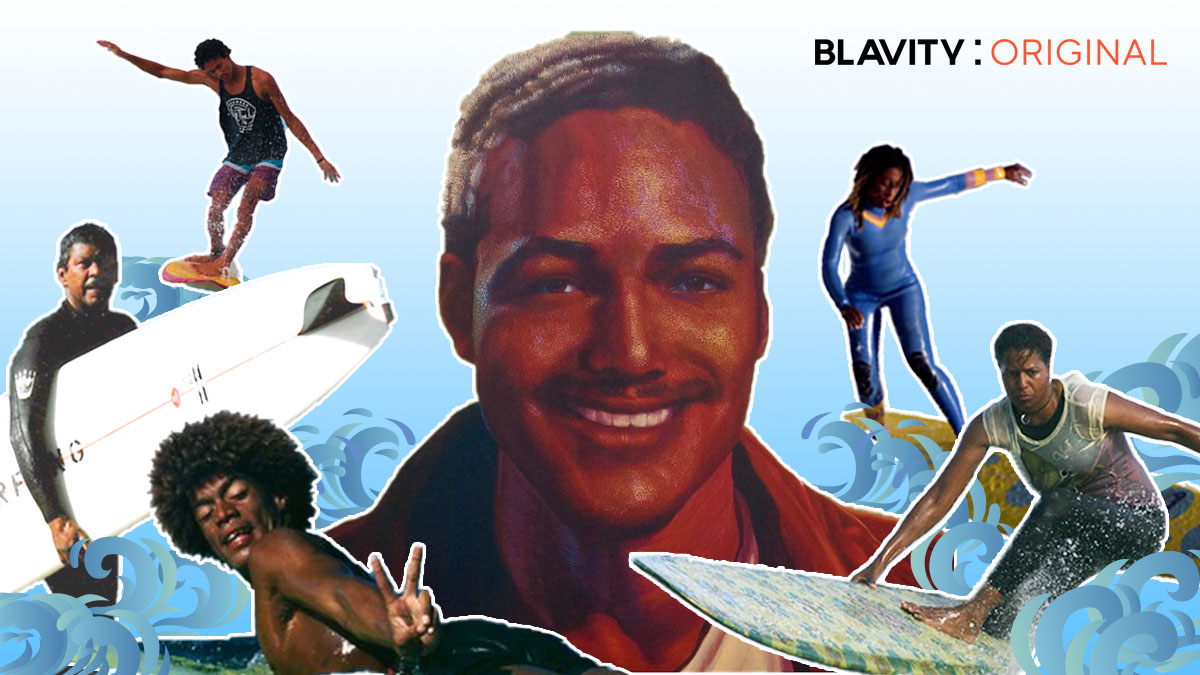Since the iconic Black surfer Nick Gabaldón broke barriers surfing at Santa Monica Beach in the late 1940s, generations of Black surfers have followed his legacy into the ocean. The problem is that the world has yet to learn about their impact. Black men and women have left their mark on the surfing world by challenging preconceived notions and using the sport as a way to deal with personal traumas and creatively express themselves. Here are some of the dopest Black surfers from past to present.
1. Nick Gabaldón
Probably the most recognizable Black surfer in history, Nick Gabaldón was instrumental in breaking down racial barriers and paving the way for future Black wave riders. He was born on February 23, 1927, in Los Angeles, California to a Black mother and Mexiacan father. During the height of segregation, the surfing icon taught himself how to master the waves. Although the segregated part of Santa Monica State Beach — known as “The Inkwell"— was essentially his playground, Gabaldón also surfed predominantly white beaches along the California coast. His presence aided in desegregation, but at the age of 24, Gabaldón lost control of his surfboard and died.
2. Montgomery 'Buttons' Kaluhiokalani
Many in the surfing world consider Montgomery "Buttons" Kaluhiokalani a true legend. In his prime, he associated with fellow iconic surfers Larry Bertlemann and Mark Liddel. Buttons was the son of a Black military father and Hawaiian mother. His mixed heritage gave him the cred to represent both cultures, challenging racism simultaneously. Famous for his tailslides and 360-degree tricks, Buttons started competing in surf competitions in his early teens, and later went on to win the Malibu Sunkist Pro in 1979. After overcoming an addiction to heroin, Kaluhiokalan tragically lost his battle with stage IV lung cancer and passed away in 2013.
3. Mary Mills
Inspiring and documenting the lives of surfers is Mary Mills' life calling. In addition to being a surfer, she's a former college soccer player, surf advocate, competitive cyclist, skater, mat rider and writer. Also known as Surf Sister, Mills picked up a mat around 2008. According to an interview with Mat Surfers, she admittedly could not swim well until age 23 and started surfing at the age of 38.
Her career has allowed her to meet all lovers of the craft, including photographers and fellow riders. Reportedly surfing nearly every beach in Los Angeles County, the lack of Black, female representation in the surf world clearly can't stop this dynamo.
"Any stereotype that folks have about who and what they’ll see in a typical surf session is completely obliterated when I’m on my mat," Mills told Mat Surfers.
4. Andrea Kabwasa
Surfing can be instrumental in spiritual healing, as longboard surfer Andrea Kabwasa mentioned in a 2012 interview. The sport helped her heal mentally after her experiences with abuse.
"When I discovered surfing, I was trying to recover from the psychological effects and residue of an abusive relationship," Kabwasa told Mary Mills for the surf magazine Liquid Salt
Unlike some of the other surfers mentioned, Kabwasa, who has been featured in several documentaries about breaking down the gender and racial barriers in the sport, didn't start riding waves until she was in her early 30s. Though the special education teacher and artist was reportedly curious about surfing since her childhood, she was initially hesitant to get on a board. She now credits surfing as being instrumental in sharpening her creative focus and teaching abilities.
5. Rick Blocker
In honor of Gabaldón, Santa Monica native and Black surfing historian Rick Blocker collaborated with the Black Surfers Collective and other local surfing advocates to help create the first Nick Gabaldón Day in 2013. Blocker first took to a surfboard around age 12. He spent most of his time riding waves at the Inkwell Beach in Santa Monica. As a child of the first bussing program in Los Angeles, he came face-to-face with racial integration while being introduced to skateboarding and surfing. Later, he went on to become a teacher and after he retired, he founded the website www.BlackSurfing.com and became a member of the Malibu Surfing Association, Diversity in Aquatics and the Black Surfing Association.
6. Michael February
Young South African surfer Michael February's father, Isaac February, was a child of the apartheid, and this racial tension limited his access to certain beaches. However, the racial animus did not stop Isaac from developing a passion for surfing, which was further cultivated by his son Michael.
Though only in his mid-20s, Michael is now a full-time, championship-tour surfer. He first went pro at several qualifying series in 2012. After winning the final in Martinique in 2015, his career really took off. In 2017, he placed third in Ballito Pro and fifth in U.S. Open of Surfing.
Surfing has since become an especially popular pastime among the Black community in South Africa. In Surfer Magazine, Michael credited organizations like Waves for Change and Surfers Not Street Children for making a difference in integrating South African surfing.
"I’m not sure if those types of programs exist in America, but I think they’ve made surfing a lot more inclusive in certain communities here," he told the magazine.
As this list proves, surfing isn't just for white people. According to Surfline historian Nick Carroll, the sport was created by people of color. A generation of young surfers from organizations like The Black Surfers Collective and Black Girls Surf are learning to break the tides; some are even vying to be Olympic stars. So when the summer heat is just too much, you can always look at the nearest beach as a place for adventure knowing Black people surf too. Black people all over the world are going to make waves of their own.

